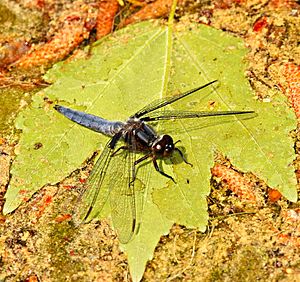Blue corporal facts for kids
Quick facts for kids Blue corporal |
|
|---|---|
 |
|
| Male | |
| Scientific classification | |
| Synonyms | |
|
Libellula deplanata |
The blue corporal (Ladona deplanata) is a cool dragonfly that lives in the eastern United States. It's also called the little corporal. This dragonfly belongs to the skimmer family, called Libellulidae. A scientist named Jules Pierre Rambur first described it in 1842. You can find it commonly across much of the eastern United States.
Understanding the Blue Corporal's Name
When the blue corporal was first discovered, scientists gave it the name Libellula deplanata. Later, another scientist created a new group, or genus, called Ladona, and moved the blue corporal there.
The word deplanata in its scientific name means "flattened." This probably describes the shape of the blue corporal's body. The "blue" part of its common name comes from the male dragonfly's color. The "corporal" part refers to two lines on its chest, called the thorax. It's like how a corporal in the US military wears two stripes on their uniform.
What Does a Blue Corporal Look Like?
The blue corporal is a small, strong dragonfly. It measures about 29 to 40 millimeters (1.1 to 1.6 inches) long.
Male Blue Corporal
The male has a dark brown chest area (thorax). It has two wide, bluish, frosty-looking stripes on the front. His body (abdomen) is also a frosty blue. His face is black, and his eyes are dark brown.
Female Blue Corporal
The female is brown. She has a thin, light-colored stripe and a thin black stripe on each side of her chest. She also has a black stripe down the middle of her body, which gets wider towards the end. Her face and eyes are brown.
Wings
Both male and female blue corporals have clear wings. They have short black streaks at the base of their wings. Sometimes, there's also a smaller amber (yellow-orange) streak between the black ones.
How to Tell Them Apart From Similar Dragonflies
- The chalk-fronted corporal is bigger. It has a spot at the base of its back wings instead of streaks. Adult male chalk-fronted corporals have a white face, not black.
- The male Eastern pondhawk has completely clear wings with no streaks at the base. It also has green eyes.
- The male blue dasher is thinner. It has green eyes and a white face.
- The male little blue dragonlet is smaller. It has clear wings and white parts at the end of its body called cerci.
Where Do Blue Corporals Live?
The blue corporal is very common and can be found all over the eastern United States. Their home range stretches from Oklahoma to New Hampshire in the north, and south to Texas and Florida.
They prefer calm, clear waters in ponds, lakes, and old mining pits with sandy bottoms. They don't breed as often in streams as some of their relatives do.
Blue Corporal Behavior and Habits
Unlike most other skimmer dragonflies, the blue corporal usually rests on the ground. Sometimes, in the late afternoon, they will cling straight up and down on sunny trees.
Males spend a lot of time flying along the edges of ponds and lakes. They rest on banks, low plants, or things floating in the water between flights. Females usually stay away from the water unless they are mating or laying eggs. The blue corporal flies low and flutters, sometimes stopping to hover in one spot.
What Do Blue Corporals Eat?
Like all dragonflies, blue corporals are hunters.
- When they are young (called instars or nymphs), they mostly eat tiny midge and mayfly larvae. They also sometimes eat small water creatures like ostracods and cladocerans.
- As adult dragonflies, they hunt flying insects. They mainly catch small flies, beetles, and leafhoppers. They are "sally hunters," meaning they make quick, short flights from a resting spot on or near the ground to catch their prey.
Life Cycle and Reproduction
Blue corporals have one group of babies (brood) each year. They mate while flying. Right after mating, the female lays her eggs. The male hovers above her to protect her. She dips her body into the water to lay the eggs. She spreads her eggs out, laying them several meters apart around the edge of a pond. She doesn't lay many eggs in any one spot.
The young blue corporals grow at the same time. This means they compete more with each other for food and space. The blue corporal spends the winter as a fully grown nymph (young dragonfly). All the dragonflies in an area emerge as adults over about one month in early spring.
The time they fly as adults changes depending on where they live:
- In Florida, they fly from November to May.
- In Louisiana, they fly from February to May.
- Further north, they emerge later in the year.
- In South Carolina, they fly from late March until early May.
- In Kansas, they fly from April to May.
- In Ohio and Kentucky, they fly from April to June.
- In New Jersey, they fly from April to July.
Conservation Status
The International Union for the Conservation of Nature has not officially checked the blue corporal's status. However, this dragonfly is known to be common across the areas where it lives.
Like all dragonflies, blue corporals face some dangers. When they are young nymphs, fish often eat them. Studies show that because of this, they tend to hide more. About 90–97% of young blue corporals die each year.

